“Leafing Through” – autumn book reviews
September 13th, 2009
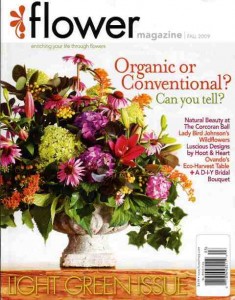 A big thanks to Amy Stewart for referring me to flower magazine, a publication I was unfamiliar with until now, for a book-review gig.
A big thanks to Amy Stewart for referring me to flower magazine, a publication I was unfamiliar with until now, for a book-review gig.
A quarterly publication, flower magazine is edited by founder Margot Shaw and managing editor Melissa Brown, who produce a gorgeous, informative, 4-color glossy for flower enthusiasts, floral designs and gardeners. They are based in Birmingham, Alabama.
The fall 2009 issue is just out and because I thoroughly enjoyed the four books I reviewed, I thought I’d share them here. I like the opening text, which helps describe my credentials:
“As a much-published chronicler of home and garden design and a Master Gardener to boot, Debra Prinzing dove into these informative selections on a variety of “green” themes:
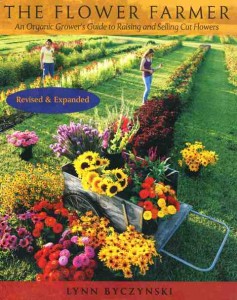 The Flower Farmer: An Organic Grower’s Guide to Raising and Selling Cut Flowers (Revised & Expanded) by Lynn Byczynski (Chelsea Green Publishing, 2008), $35.
The Flower Farmer: An Organic Grower’s Guide to Raising and Selling Cut Flowers (Revised & Expanded) by Lynn Byczynski (Chelsea Green Publishing, 2008), $35.
Lynn Byczynski is the godmother of the organic flower movement. Little more than a decade after she wrote The Flower Farmer, the rest of the flower world is finally catching up with her visionary ideas and practices. This updated version brims with photographs, planting plans and profiles of innovative cut flower growers, making it the definitive resource for anyone who raises and markets flowers as a commercial venture.
If you’re like me and you want to grow simply for your own enjoyment, this book is equally important. Professional floral designers will find Byczynski’s ideas illuminating, as they advocate establishing relationships with organic farmers and growers to expand a florist’s repertoire.
Writing from Wild Onion Farm, her Lawrence, Kansas-based homestead, Byczynski says she discovered flower farming serendipitously (she planted zinnias among her tomatoes and soon discovered how well they sold at the local farmer’s market). This eco-entrepreneur outlines a gentle manifesto for sustainable practices, asking “Why Organic Flowers?” The answers are revealed in every useful chapter of her 266-page guide. Even if you aren’t persuaded that organic growing practices improve soil fertility and ensure the health of farm workers and their customers alike, the argument for organic is won by the sheer bounty and beauty of the flowers themselves.
Byczynski outlines the most reliable varieties and specific cultivation and handling advice for more than 100 kinds of specialty cut flowers (from Achillea to Zinnia). These blooms are called “specialty,” she explains, “Because they transcend the standard floral fare of roses, carnations, and chrysanthemums. They are considered good cut flowers because they have long stems and a vase life of at least five days.” Once you’ve grown a collection of fresh, seasonal and local varieties, try Byczynski’s easy-to-follow design ideas.
“If you really do love flowers, and you find joy in growing and selling them, you will succeed,” she promises. Change the word “sharing” to “selling” and her words are equally appropriate for anyone who plants a row of zinnias.
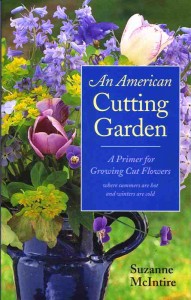 An American Cutting Garden: A Primer for Growing Cut Flowers, by Suzanne McIntire (University of Virginia Press, 2002), $16.95.
An American Cutting Garden: A Primer for Growing Cut Flowers, by Suzanne McIntire (University of Virginia Press, 2002), $16.95.
The extended subtitle of Suzanne McIntire’s highly personal volume of flower-growing advice is “. . . where summers are hot and winters are cold.”
Though I live in Los Angeles, McIntire’s guide is still informative and useful, since many of the 200 flowers she profiles will grow in my garden, as well as in her northern Virginia one.
After addressing important infrastructure decisions, the author gets down to the toughest choice you’ll face – choosing which flowers to grow. “. . . it’s not long before you realize there are many more plants out there than you can grow in a lifetime,” she acknowledges.
McIntire’s writing hints at years getting soil under her nails and dirt on her knees. I like the useful advice, such as: “The gardener who has no yellow is missing something important” or “Red is the surprise that a bouquet often needs.”
Her planting, harvesting, and arranging advice is geared toward the gardener-floral designer. It’s okay to space plants in a cutting garden closer together than you would in a display garden to increase their yields, she says.
She is anything but a perfectionist, a breath of fresh air to those tired of floral designs that seem unrelated to nature. “I prefer to spend only a few minutes to help flowers look their best, and often it comes down to selecting the right vase, choosing good vase companions for a given flower, and adjusting stem lengths by shortening where necessary,” McIntire confides.
If you need inspiration for how to start a cutting garden, the book offers four design concepts, including ones for beginners, small spaces, shady sites and autumn interest. Each of McIntire’s detailed flower narratives is worth losing yourself in. I only wish there were more than the rather limited 28 color images as illustrations. You’ll need a photo-rich plant encyclopedia on hand for her lesser-known suggestions, such as Anchusa azurea (Italian bugloss, a forget-me-not relative) or Kalimeris pinnatifida (Japanese aster). But that’s just a small complaint. Without McIntire’s book, I wouldn’t have found them in the first place.
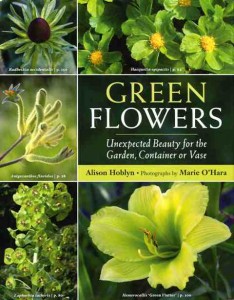 Green Flowers: Unexpected Beauty for the Garden, Container or Vase, by Alison Hoblyn with photographs by Marie O’Hara (Timber Press, 2009), $24.95.
Green Flowers: Unexpected Beauty for the Garden, Container or Vase, by Alison Hoblyn with photographs by Marie O’Hara (Timber Press, 2009), $24.95.
The full spectrum of green is the backbone of any garden scheme. Green is also the essential ingredient in any floral arrangement. But often these verdant elements are taken for granted, or, worse, not thoughtfully incorporated. Think about the prosaic green shrub practically ignored in a landscape. Or, consider the generic “filler” foliage that might be shiny or fluffy in a bouquet, but quickly forgotten in contrast to a Stargazer lily or the classic red rose emerging from all that green.
Green Flowers offers a lovely alternative and a reminder that green is, indeed, a color! Both writer Alison Hoblyn and photographer Marie O’Hara live in England, but many of the flowers they profile are available in North America (although none are commonplace).
I like that Hoblyn – who has worked as a designer, illustrator and painter – offers an artistic explanation for green’s usefulness. Not only does green have neutral and restful qualities, but it also unifies any palette. “On the colour wheel, it occupies that middle land between the hot hues of red and the colder climes of blue,” she explains.
Gardeners and florists usually cast green as supporting player in their designs, as foliage. But there are plenty of extraordinary plants with green flowers or flower-like bracts and modified leaves. Each plant profiled in the book is paired with an attractive, full-page photograph (although sometimes the images are so tightly focused on the bloom it is impossible to envision the size or form of a mature plant). I appreciate the inclusion of other recommended cultivars, as well as sidebars including little-known traits about each plant.
For example, the seeds of Amaranthus caudatus ‘Viridis’ (love-lies-bleeding), an exotic, tassel-like flower that looks beautiful in a container garden or as a cut flower, are a good source of iron, magnesium and fiber. Moluccella laevis (Bells of Ireland), has been cultivated since the 16th century, is in the mint family, and has its origins in Turkey, not Ireland.
After falling in love with Green Flowers, you’ll want to grow and design with Mother Nature’s favorite color as revealed in her blooms, blades, and leaves. Whether the star of your bouquet (or border) or a harmonizing design element, green will never again seem ordinary.
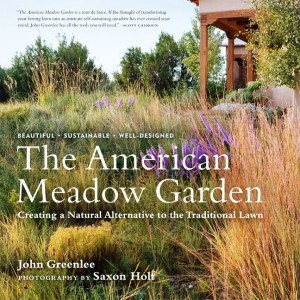 The American Meadow Garden: Creating a Natural Alternative to the Traditional Lawn, by John Greenlee with photography by Saxon Holt (Timber Press, 2009), $39.95.
The American Meadow Garden: Creating a Natural Alternative to the Traditional Lawn, by John Greenlee with photography by Saxon Holt (Timber Press, 2009), $39.95.
“Meadows are far more satisfying than either a lawn or traditional border, combining the best attributes of both: like a lawn, a calming place for the eye to rest, yet with the richness and complexity of a border.” John Greenlee’s opening lines are so compelling to read, because they open up the imagination to the practical and eye-pleasing alternatives to a monochromatic (and water-hogging) sea of turf.
“Unlike lawns, meadows are better for the environment, a safe habitat for beneficial insects and pollinators, a place where native ecology can thrive,” he continues. Yet meadows aren’t like a roll of sod that can be unfurled across a patch of soil. They need to be properly designed, installed and maintained, which is reason enough to read and emulate the ideas in Greenlee’s book, available in November.
Owner of Greenlee Nursery, the oldest grass nursery in California, the author has created grass ecologies in gardens since 1984. Greenlee (the “Grass Guru”) pioneered the use of native grasses in ornamental landscapes and advocates for a redefinition of American yards. The American Meadow Garden offers homeowners a new model – a mini ecosystem friendly to children, pets and wildlife. That it requires minimal resources and zero mowing is yet another argument in favor of this anti-lawn.
Saxon Holt’s evocative photography is equally persuasive, for when you see the way sunlight plays off the seed heads and wildflowers that compose Greenlee’s meadows, “dream-like” is the only word that comes to mind.
“A meadow can be quiet and green, or filled with riotous displays of flowers and color,” Greenlee expounds. Non-green grass varieties are listed, such as those with silver, blue, yellow, gold and white hues. Flowers, too, play a large role in the meadow tapestry. The diversity of flowering bulbs, daisies, penstemons, salvias, poppies and ferns that Greenlee likes to sprinkle through his meadows will amaze you.
I love the detailed lists of grasses for fragrance, groundcovers, great flower heads, seasonal effects, background and “fillers.” Then there’s “grasses for billowy or cloudlike flowers,” which plays right into my dreamlike notion of growing a meadow of my very own.









September 14th, 2009 at 7:25 am
Debra, thanks for highlighting these fabulous garden books. I was not familiar with any of them….Bonnie
.-= Bonnie Manion´s last blog ..How To Fan Espalier A Fruit Tree =-.
September 14th, 2009 at 8:53 am
Wonderful! What a great gig and it’s your perfect element. Homegrown flowers & food – I’m a happy gal!
.-= Lorene´s last blog ..Celebrating a Local Harvest =-.
October 31st, 2009 at 5:31 pm
What a wonderful assortment of floral books you present. I especially like the American Cutting Garden. This presents a great way to save on making you own flower arrangements for a very low cost. Well done!
.-= Judith Babb´s last blog ..How to Make your Out of Town Guests Feel At Home =-.
November 21st, 2010 at 4:36 pm
[…] Guide to Raising and Selling Cut Flowers (Chelsea Green Publishing, 2008). I love her book (read my review here) and I knew Lynn would have a lot of good information to share with her peers. Her talk, ” […]